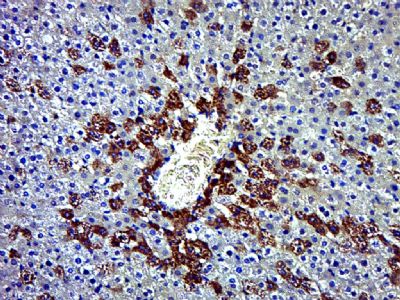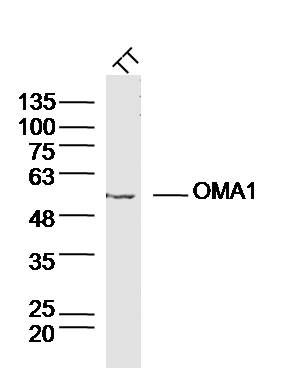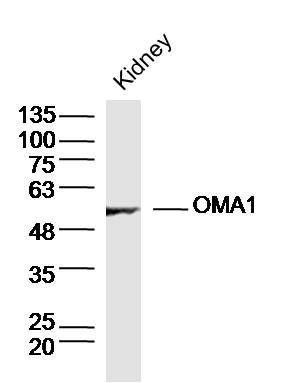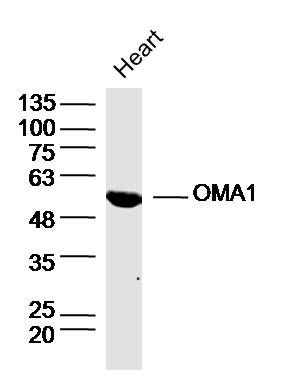Application 
| WB, IHC-P, IHC-F, IF, ICC |
|---|---|
| Primary Accession | Q96E52 |
| Reactivity | Rat, Pig, Cat, Bovine |
| Host | Rabbit |
| Clonality | Polyclonal |
| Calculated MW | 60120 Da |
| Gene ID | 115209 |
|---|---|
| Other Names | Metalloendopeptidase OMA1, mitochondrial, 3.4.24.-, Metalloprotease-related protein 1, MPRP-1, Overlapping with the m-AAA protease 1 homolog, OMA1 {ECO:0000303|PubMed:20038677, ECO:0000312|HGNC:HGNC:29661} |
| Dilution | WB=1:500-2000,IHC-P=1:100-500,IHC-F=1:100-500,ICC=1:100-500,IF=1:100-500 |
| Format | 0.01M TBS(pH7.4), 0.09% (W/V) sodium azide and 50% Glyce |
| Storage | Store at -20 ℃ for one year. Avoid repeated freeze/thaw cycles. When reconstituted in sterile pH 7.4 0.01M PBS or diluent of antibody the antibody is stable for at least two weeks at 2-4 ℃. |
| Name | OMA1 {ECO:0000303|PubMed:20038677, ECO:0000312|HGNC:HGNC:29661} |
|---|---|
| Function | Metalloprotease that is part of the quality control system in the inner membrane of mitochondria (PubMed:20038677, PubMed:25605331, PubMed:32132706, PubMed:32132707). Activated in response to various mitochondrial stress, leading to the proteolytic cleavage of target proteins, such as OPA1, UQCC3 and DELE1 (PubMed:20038677, PubMed:25275009, PubMed:32132706, PubMed:32132707). Involved in the fusion of the mitochondrial inner membranes by mediating cleavage of OPA1 at S1 position, generating the soluble OPA1 (S-OPA1), which cooperates with the membrane form (L-OPA1) to coordinate the fusion of mitochondrial inner membranes (PubMed:31922487). Following stress conditions that induce loss of mitochondrial membrane potential, mediates cleavage of OPA1, leading to excess production of soluble OPA1 (S-OPA1) and negative regulation of mitochondrial fusion (PubMed:20038677, PubMed:25275009). Involved in mitochondrial safeguard in response to transient mitochondrial membrane depolarization (flickering) by catalyzing cleavage of OPA1, leading to excess production of S-OPA1, preventing mitochondrial hyperfusion (By similarity). Also acts as a regulator of apoptosis: upon BAK and BAX aggregation, mediates cleavage of OPA1, leading to the remodeling of mitochondrial cristae and allowing the release of cytochrome c from mitochondrial cristae (PubMed:25275009). In depolarized mitochondria, may also act as a backup protease for PINK1 by mediating PINK1 cleavage and promoting its subsequent degradation by the proteasome (PubMed:30733118). May also cleave UQCC3 in response to mitochondrial depolarization (PubMed:25605331). Also acts as an activator of the integrated stress response (ISR): in response to mitochondrial stress, mediates cleavage of DELE1 to generate the processed form of DELE1 (S- DELE1), which translocates to the cytosol and activates EIF2AK1/HRI to trigger the ISR (PubMed:32132706, PubMed:32132707). Its role in mitochondrial quality control is essential for regulating lipid metabolism as well as to maintain body temperature and energy expenditure under cold-stress conditions (By similarity). Binds cardiolipin, possibly regulating its protein turnover (By similarity). Required for the stability of the respiratory supercomplexes (By similarity). |
| Cellular Location | Mitochondrion inner membrane; Single-pass membrane protein {ECO:0000250|UniProtKB:Q9D8H7} |
| Tissue Location | Widely expressed, with strong expression in the heart, skeletal muscle, kidney and liver |









